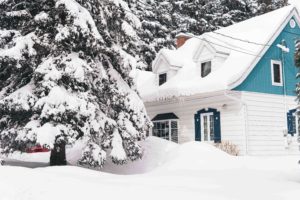Top 10 Winter Energy Saving Tips

The U.S. Energy Information Administration is expecting 41% of homes to spend 15% more on electricity this coming winter. With the rise of prices, inflation, and everything else going on in the world, it’s important to do everything you can to help reduce your bills.
One of those is your rising utility bill during the colder months of the year. There are quite a few things that you can do to save on your winter energy bill and we are going to show you some of the most cost effective and easiest things that homeowners can do.
Follow these winter energy saving tips and you’ll be sure to see a decrease in your energy bills this winter!
Winter Energy Saving Tips
On average, residential homeowners use around 706kWh per month in energy during the winter, compared to 505 kWh during the summer. This comes out to being right around $105 for your winter energy bill. However, if we are going to estimate the increase of 15% this coming winter, that average will increase to be around $120.
With that being said, here at Thomas Service Company, we are always looking out for our neighbors. Which is why we’ve put together a list of winter energy saving tips.
We’re going to break these down into several sections:
- Winter energy saving tips with no upfront cost
- Winter energy saving tips with low upfront cost
- Winter energy saving tips with upfront cost
So no matter what kind of options you are looking for, we have some that you can take advantage of!
Winter Energy Saving Tips with No Upfront Cost

Our winter energy saving tips with no upfront costs are exactly that, they are small things that you can do in your home to help reduce your utility bills, without having to invest more money first.
If you’re on a tight budget or if you want to keep things simple, these are a great option for you!
Set Your Thermostat
Start by setting your thermostat to 68°. Your heating system will operate less and use less energy. Turn your thermostat down 5° at night or when leaving your home for an hour or more to save up to $70 on energy costs each year.
For a small investment, consider purchasing a programmable thermostat to adjust your home’s temperature settings automatically while you’re sleeping or away.
Set Your Water Heater
Set your water heater to 120°. It’s simple. Your water heater won’t have to work so hard if it’s set at a lower temperature. The temperature control settings on water heaters either indicate “low, medium, and high” or actual temperature settings.
Simply consider turning down your water heater to a slightly cooler setting to reduce the amount of energy used to heat the water while still keeping the water warm enough for home use. In fact, each time you lower the temperature by 10°F you’ll save 3–5% on your water heating costs. That’s a savings of $6-$10 a year.
For a small investment (~ $20) consider adding a water heater blanket to your water heater tank to insulate the tank and reduce the amount of energy used to maintain warm water. Be sure to follow your manufacturer’s recommendations.
Utilize Natural Sunlight
In the winter, make the most of sunlight by opening window coverings on south-facing windows to warm your home. Also, consider closing window coverings in rooms that receive no direct sunlight to insulate from cold window drafts.
At night, close the window coverings to retain heat inside. Up to 15% of your heat can escape through unprotected windows, but the solar heat gained from the sun during the day can conserve valuable energy.

Wash Your Clothes in Cold Water
Start using cold water in your washing machine to do your laundry. According to ENERGY STAR, washing clothes in cold water will save you about $66 a year!
Clothes don’t need hot water to get clean, so by making a simple switch from hot to cold water, you could be saving on your utility bills by quite a bit.
Replace Your Pump Filter Often
Replace your furnace or heat pump filter regularly. Dirty filters reduce airflow, making your equipment work harder and use more energy. Replace your furnace filter monthly (unless it is a high-efficiency filter designed to last several months) during the heating season to reduce heating costs by up to 5%.
If you don’t feel comfortable doing this kind of HVAC maintenance or if you just don’t have time, consider hiring a local HVAC company to come out and do it for you on a monthly basis. Many local HVAC companies such as Thomas Service Company offer monthly HVAC maintenance plans to provide these types of services.
Energy Saving Tips for Winter with Low Costs
Now that we’ve covered all of the ways you can save with no upfront costs, let’s talk about some energy saving tips for winter with low costs. By simply investing a small amount of money now, you can save much more in the long run.
Here are a few things that you can do to help save only your utility bills!
Get an AC Tune Up
A more comprehensive AC tune-up of existing air conditioning and heat pumps has the potential to provide a significant opportunity for reducing peak demand and energy consumption.
The common problems with installed systems include things such as low airflow and incorrect charge, which both contribute to reduced operating efficiency. Studies have indicated that 60%-70% of installed residential air conditioning systems have improper refrigerant charge and/or inadequate airflow. The average energy savings potential from addressing improper refrigerant charges can be as much as 12%!

Switch to Fluorescent Light Bulbs
Switch to compact fluorescent light (CFL) bulbs. They cost a little more, but you can save about $40 over the life of just one bulb. Fluorescent light bulbs use much less energy than your regular ones do, which means by switching out all of your bulbs, you could be potentially saving quite a bit on your monthly electricity bills.
Weatherize Your Home
Weatherize your home and save up to 10% of your heating and cooling costs. A handy homeowner can seal up holes to the outside by weather-stripping doors and sealing windows and gaps along the home’s foundation.
Go around your home and find where there may be holes, cracks, crevices, and anything else where cold air could be seeping in or warm air escaping.
Home Energy Saving Tips for Winter with Upfront Costs
You now have a list of things you can do to help save on energy that has no upfront costs and a few options that have a low upfront cost. Lastly, we have a few home energy saving tips for winter with upfront costs.
Let’s take a look!
Insulate Your Home
Insulate your home! The easiest and most cost-effective way to insulate your home is to add insulation in the attic. Other effective places to add insulation include unfinished basement walls and crawlspace.
Insulating walls can be more complex, so check with a contractor for advice. When insulation is correctly installed AND the home is totally weatherized, the average home can see a savings of up to 20% of your heating and cooling costs.

Use Energy Star Appliances
Purchase ENERGY STAR® appliances. A smart choice that can lead to huge savings. Appliances and electronics really contribute to your energy bill. When it is time to replace, remember items like refrigerators, washers, dryers, furnaces, TVs, and computers have two price tags–purchase price and lifetime energy cost.
According to ENERGY STAR, the average homeowner spends about $2,000 on energy bills every year. Compared to appliances that have earned the ENERGY STAR rating, and you can save $75 a year in energy costs while also saving the environment!
Winter Energy Saving: The Right Way
There are many ways to save on winter energy costs, some of which have no upfront costs and others that have a low upfront cost. By following the tips we’ve provided, you can start saving money right away on your monthly utility bills.
Whether you decide to weatherize your home, switch to fluorescent light bulbs, or get an AC tune-up, there are plenty of options for reducing your winter energy bill!
If you have questions about saving on your energy this winter or if you need an HVAC professional to come out to your home, be sure to get in touch with our team today!
